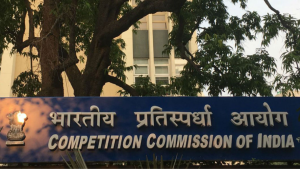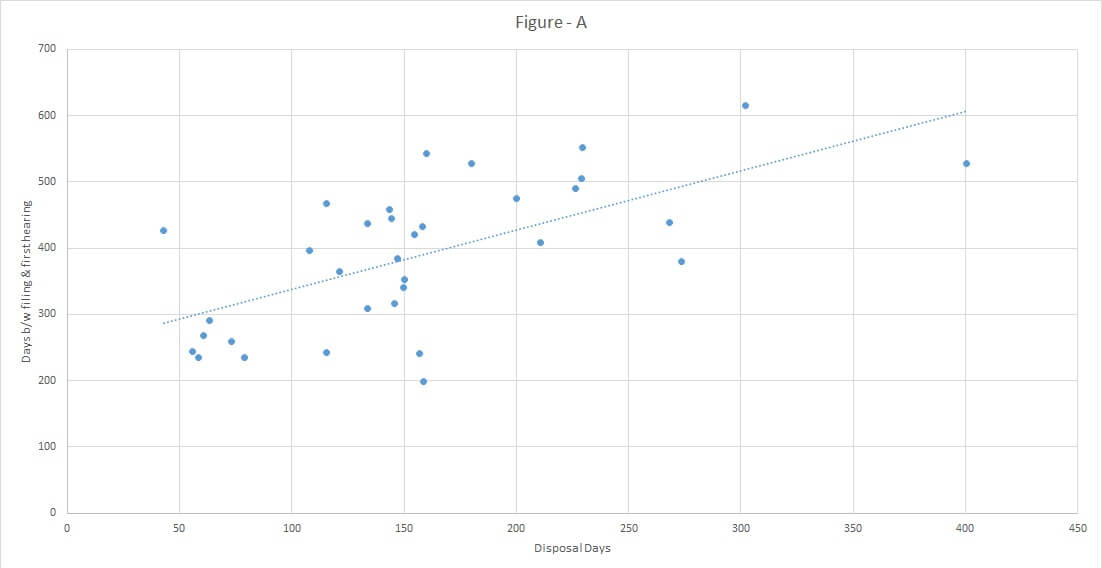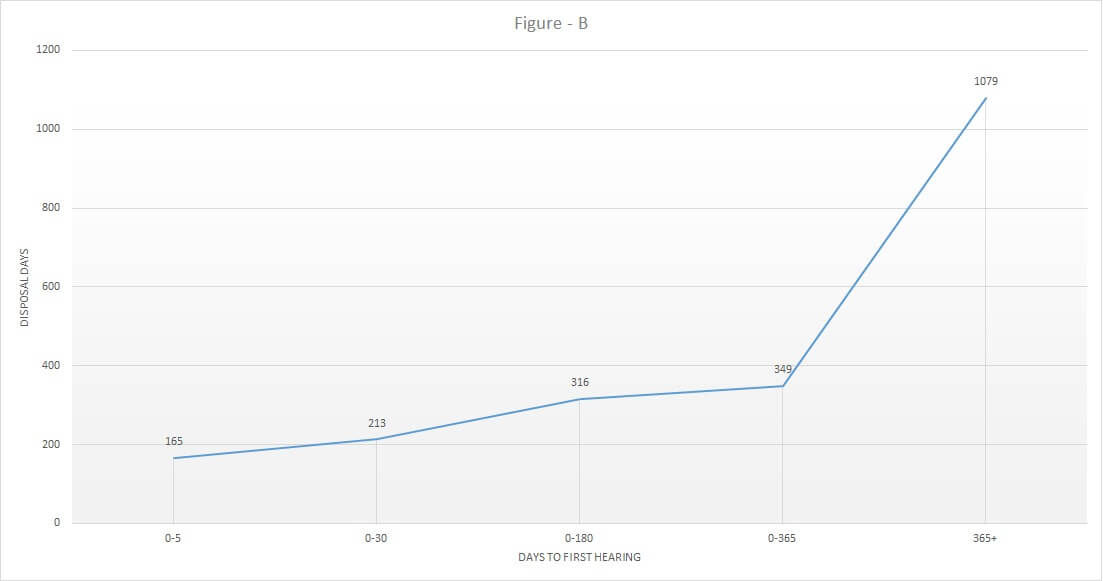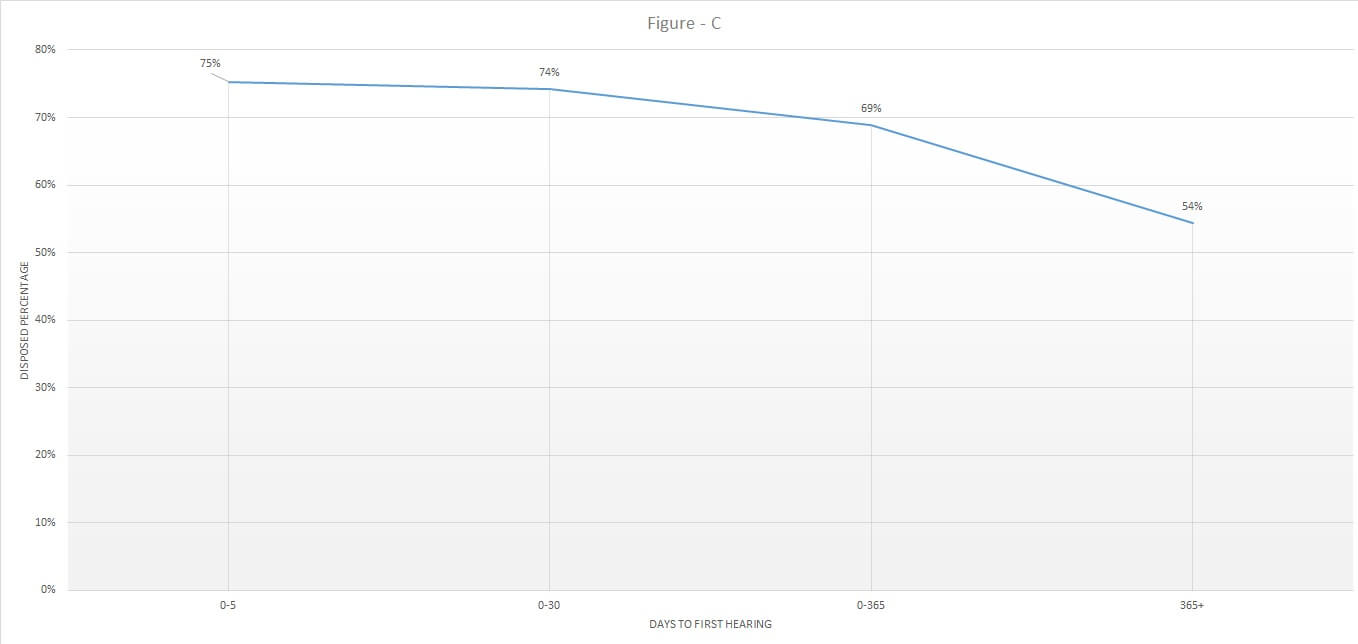

Leading Indicator of Case Duration
Early hearing of a case gives confidence to the plaintiff in the justice system who thinks his/her rights are being violated. An analysis done on 3 million cases across 3000 subordinate courts in India shows the relationship between time taken for first hearing and the case performance (assessed by time taken to dispose a case). We have tried to analyse the impact from three different perspectives. For the cases (2 million) that were filed and resolved between 2010 and 2016, it took an average of 15 months to dispose. It takes an average of five months for a case to be heard for the first time.
An analysis of the disposed cases in subordinate courts shows that there is moderate-strong positive correlation between the time it takes to hear a case for the first time and the case duration. The correlation coefficient is 0.63 (trend-line in Figure – A), which means that, as the number of days taken to hear the case for the first time increases, the disposal days also increases. The scatter plot below illustrates the relationship between days taken for first hearing and disposal days. There are 34 data points in the plot, each representing state or a union territory. The average disposal days is plotted on the X axis and the average day’s b/w filing and first hearing on the Y axis. The plot suggests that as the time taken to first hear the case increases, the disposal time also increases. This shows that time taken to first hear the case is a leading indicator of disposal time. By looking at how long it took for a case to come before the judge for the first time, we can estimate the time it will take to dispose of the case.
The line graph in Figure – B, shows the relationship of the cases that were first heard within 5 days, 1 month, 6 months, 1 year respectively and days to dispose. The graph analyses disposed cases that were filed between the year 2010 and 2016. A case if heard within 5 days takes on average 165 days to dispose, 213 if heard within 1 month, 316 if heard within 6 months, 349 if first heard within 1 year and 1079 days to dispose if first heard after 1 year. This indicates that it takes less days to dispose if the case is first heard early on.
The line graph in Figure – C, illustrates the percentage of the disposed cases that were heard within 5 days, within 1 month, within 1 year and more than 1 year respectively. The graph analyses those cases that were filed between the year 2010 and 2016. 75% of the cases whose first hearing was within five days are disposed, 74% for cases which were heard within 30 days and 69% for cases within a year (as of 31st December, 2016). Of all the cases that were first heard after 1 year, only 54% of them are disposed as of 31st December, 2016. This indicates that the cases that are first heard early have a higher chances of getting redressed early.
Therefore, the next time you file a case you will be able to get a rough estimate on how many days will it take for the case to dispose. But a word of caution – correlation does not imply causation. What this means is that by simply improving the first date of hearing, one cannot guarantee an early disposal time. The causality behind this needs further investigation and will be discussed in the next blog.
The views expressed in this article are solely those of the author’s and they do not represent the views of DAKSH.

Ahmed Pathan
RECENT ARTICLES


Testing the Waters: Pre-Implementation Evaluation of the 2024 CCI Combination Regulations

Not Quite Rocket Science

Administration of justice needs an Aspirational Gatishakti

-
Rule of Law ProjectRule of Law Project
-
Access to Justice SurveyAccess to Justice Survey
-
BlogBlog
-
Contact UsContact Us
-
Statistics and ReportsStatistics and Reports
© 2021 DAKSH India. All rights reserved
Powered by Oy Media Solutions
Designed by GGWP Design


